NGC Ancients: Caesar and Brutus - A Brief Survey
Posted on 12/17/2012
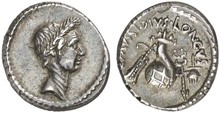
Julius Caesar and Brutus represent two of the most famous Romans in history, and their names will forever be intertwined by the monumental events of 44 BC. The two struggled for center stage during the most dynamic period in Roman history, when the government underwent a violent transition from a relatively democratic republic to the greatest empire in recorded history. This monumental change required about fifty years of struggle in the 1st Century BC, and altered the course of Western history in ways which still affected hereditary monarchies into the 19th Century.
The most interesting aspect of this period is the people themselves – it encompasses both the warlords who struggled for supremacy and those who fought to restore the Republic, which for decades had been in decline. The democratic concept of the Republic was laudable, but participation was limited to the nobility, who often resorted to bribery, patronage, and strong-arm tactics.
Keenly aware that the days of the Republic were coming to a close, a handful of warlords tried to create a monarchy, which they hoped to lead. Their coins are popular among collectors, causing them to command prices many times that of obscure coins which are much rarer.
Among the historical luminaries of this age, two names stand above the rest: Caesar and Brutus. The most famous of all Romans, Julius Caesar’s life story has been chronicled by countless historians and dramatized by the likes of Shakespeare. His rise occurred late in his life, but once it began it was a great success. Caesar’s ambition was unmatched, and his political connections and acumen were well suited to his goal of winning supreme authority in Rome.
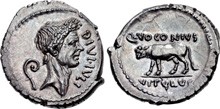
Caesar was the first Roman to place his image on a coin minted in Rome during his lifetime, a provocative act which certainly contributed to his murder soon thereafter. His portrait appears on coins struck in gold, silver, and copper. Some were issued by Caesar himself and others were struck after his death by his political contemporary Marc Antony and by his adoptive nephew and heir, Augustus (Octavian). This silver denarius, struck in 40 BC (four years after Caesar’s death), bears an exceptional portrait of the slain dictator. The reverse displays a bull calf and the surname of the moneyer, Q. Voconius Vitulus.
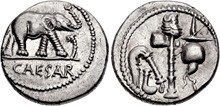
Coins that feature the portrait of Caesar are generally expensive, but there are affordable alternatives for collectors. This denarius, which is probably the most common coin of Caesar, was struck 49-48 BC at a military mint traveling with the dictator. The obverse shows an elephant trampling a serpent, while the reverse features various implements of the pontificate.
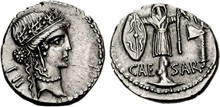
Another of the more affordable of Caesar’s issues is this denarius, again struck in about 48 BC at a traveling military mint. The obverse displays a diademed female head, perhaps the goddess Clementia. Interestingly, the letters behind the head (“LII”) are thought to represent Caesar’s age in the year 48 BC, which would have been 52. On the reverse there is a Gallic trophy of arms, again with various implements displayed.
Caesar’s rise to power was checked only by his murder on the Ides (15th) of March, 44 BC, when a group of conspirators led by Brutus and Cassius carried out the act. He was assassinated in the Senate house on the very day he was expected to ask the Senate to raise his status from “perpetual dictator” to “king” before he mounted a campaign against enemies in the East.
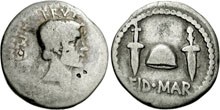
As for Brutus, there are two opposing historical perspectives on his character: to some he was a champion of liberty who failed because of his virtues, and to others he was a traitor of the lowest order. He is best remembered by historians for his leading role in the assassination of Julius Caesar, and by numismatists for his remarkable “Ides of March” coinage, which shows his own portrait on the obverse and on the reverse a liberty cap (pileus) flanked by two daggers above the legend “EID. MAR.” Perhaps the most remarkable coin ever issued by the Romans, it serves as a testament to the power of coinage as tools for political propaganda. By striking this coin, Brutus and Cassius were attempting to portray the murder of Caesar as a necessary part of their struggle for the Republic.
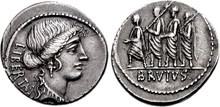
For those seeking a coin of Brutus that is more affordable than the pricey Eid Mar denarius, the denarius illustrated here is an attractive option. This coin, issued by Brutus when he served as a moneyer (mint director) in 54 BC, depicts a bust of Libertas on the obverse. The reverse shows the consul L. Junius Brutus (an ancestor of Brutus and traditionally considered one of the founders of the Republic) between two lictors – essentially bodyguards. An accensus, a member of the light infantry of Roman times, leads the procession.
In the end, Brutus and Cassius were defeated by the combined forces of Marc Antony and Octavian in 43 BC. All hopes for a renewed Republic ended with this epic battle fought over two days. It would take about another fifteen years, but the empire eventually took shape under Octavian (renamed Augustus in 27 BC) after he defeated his former ally Antony at the battle of Actium in 31 BC.
Images courtesy of Classical Numismatic Group.
Stay Informed
Want news like this delivered to your inbox once a month? Subscribe to the free NGC eNewsletter today!
